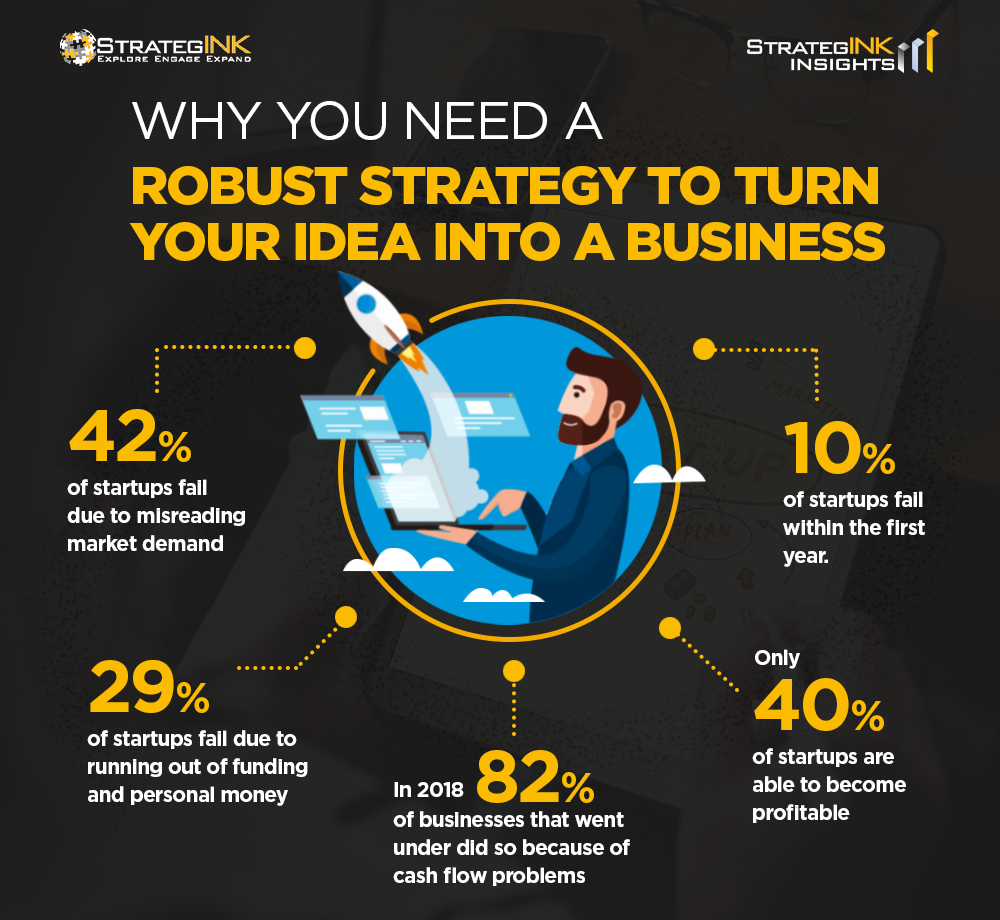
Points in focus
- Turning an idea into a business reality starts with establishing a business need by highlighting market demand
- Create milestones to visualize the journey and speed breakers before embarking on the ride
- Have a robust financial plan to ensure your idea is financially viable
- Start with a proof of concept to gain initial traction
- Think about scale from day 1 with a focus on marketing, networking and connecting
We have always heard that an innovative idea is hard to come by. However, if you sit with any entrepreneur or a startup founder, you will understand that having an innovative idea to disrupt the market is only the beginning. The journey to a successful startup is filled with opportunities and challenges, which can be overwhelming at times, but if you play it right, and have a little patience, you can transform your idea into a successful business. Based on inputs from successful startup founders and experts in the field, we have created a list of five steps that can help startups in the growth phase to accelerate their journey.
- 42% of startups fail due to misreading market demand42% of startups fail due to misreading market demand
- 29% of startups fail due to running out of funding and personal money
- In 2018, 82% of businesses that went under did so because of cash flow problems
- 10% of startups fail within the first year.
- Only 40% of startups are able to become profitable
5 Steps of Startup Evolution Journey
Step 1: Perform market research
Simply having an idea is not enough to create a successful business. Your idea needs to be backed with adequate research to illustrate the need and demand for your business. If you are unable to meet market demands, chances of finding success will become difficult. Research shows that 42% of startups fail due to misreading market demand. There are several facets to this market research, including:
Gap analysis
Start by understanding the gap or the problem you seek to bridge. This refers to highlighting what problem you are trying to solve. Answering these questions can be a comprehensive first step:
- What problem are you trying to address?
- Why did you pick this particular problem?
- What is the impact of the problem if left unaddressed?
- Are there any existing solutions for the problem in the market?
- What are the challenges with the current solutions?
- How will your solution address the untreated challenges in the market?
- Do you have the expertise/ experience/ passion to solve the problem?
Competitor mapping
Next, you need to gain a firm understanding of who you will be competing against and how you plan to thrive in the market. These questions can help you map your competitors:
- Who are the other players in the market?
- How will you differentiate yourself from those currently leading the space?
- What are your advantages for solving this problem?
- What are your strengths, weaknesses, opportunities and threats (SWOT) as compared to your competitors?
Target audience study
Finally, your research should focus on comprehending the needs of those who your idea seeks to benefit, i.e. your target audience. You can start by researching on these questions:
- Are you targeting individuals (B2C) or businesses (B2B)?
- Who is your target audience?
- How are they impacted by this problem?
- Are they looking for a solution that your idea seeks to provide?
- Are they currently engaging with existing solutions in the market?
- What will be the USP for them to engage with your solution?
- How do you plan to reach your target audience?
- Step 1: Perform market research: Understand market demand, map your competitors, and study the target audience
- Step 2: Create a roadmap: Gauge what your idea will look like in 5-10 years and how you will convert your MVP to scale
- Step 3: Develop a financial plan: Measure the financial viability for your business along with the investment requirements and resources
- Step 4: Create an MVP: Capture market reaction and build initial credibility
- Step 5: Focus on going to market at scale: Expand your reach and impact with market activation and ecosystem supporters
Step 2: Create a roadmap
Based on this research, you will have a fair idea of whether or not a demand for your product exists. If your results are positive and there exists a segment that will find your solution ideal, you need to start creating a roadmap to translate your idea into a business strategy on paper. To create a robust roadmap, you should know:
- Where do you see your business in the next 2,3,4 and 5 years?
- What will be the key milestones you will measure for success?
- How much time will it take for you to convert your idea into an MVP?
- How will you reach your target audience?
- When do you plan to start your customer outreach?
- What is the type of infrastructure you will need?
- Who will be the people responsible for translating your idea into a business?
- Do you have a board of advisors to guide you in the journey?
- What kind of partnerships will you need to get started and scale?
- What is your go-to-market strategy?
- Do you have an enabling ecosystem to get started?
- What is the expected lifetime value of your customers?
- How will you build onto your MVP for scale?
You may not have answers to all these questions on day one. However, as you move forward in your journey, many of these answers will come to the forefront. Having these answers will help you in prioritizing your efforts in the right direction as opposed to boiling the ocean in the beginning itself. For instance, if you have a vision for 5 years, you will be able to undertake reverse calculation to comprehend when your MVP should be ready and when you would need to scale. Each of these questions are interdependent to create a roadmap for success.
Step 3: Develop a financial plan
Once you have a basic roadmap in place, you will be in a comfortable place to create your financial plan. Normally, your financial plan will push you to edit and modify your roadmap depending on your budget constraints, in flow, etc.
The lack of a financial plan can lead to quick drying up of funds. According to research, 29% of startups fail due to running out of funding and personal money. Furthermore, in 2018, 82% of businesses that went under did so because of cash flow problems. To develop a financial plan, you must know:
- What is the initial investment requirement to get your solution off the ground?
- What will be your monetization model?
- Will customers be paying for your solution? If yes, what will it be priced at?
- What is the anticipated break even point for your business?
- What will be the investment required over a period of 5 years?
- What is the projected revenue generation for the next 5 years?
- What is the nature of the key expenses projected for the next 5 years?
A robust financial plan will help you gauge the viability of your business. If there is a serious disconnect between the revenue (from different sources) v/s the investment and a lack of initial capital, it will become extremely difficult for you to survive in the market.
Step 4: Create an MVP
Once all your plans and roadmap are on paper, it’s time to translate the idea into a reality by creating an MVP or a minimum viable product. An MVP will help you as a proof of concept when you take your solution to investors, customers or anyone else. It will help illustrate that you have a strong foundation beyond an idea to facilitate credibility and secure confidence. An MVP is essentially a working and usable solution based on which you can collect user feedback. Creating an MVP will help you secure your initial few customers who might also form the test bed for innovation and improvement. Depending on your idea and personal experience and expertise, as a startup founder you will need to:
- Hire the right resources to create the MVP
- Document user feedback
- Have a landing page for your solution to help users know what you are trying to sell
- Start with basic features and add intricacies gradually
- Capture UX and UI feedback
Step 5: Focus on going to market at scale
Now that your MVP is in place and you have modified the solution based on initial customer feedback, it’s time to think about scale. If you have a product business, you will need to anticipate customer needs and build on scale. If you have a service business, you will need to calibrate your systems to manage the anticipated scale. This is generally referred to as a Go-To-Market plan where you prepare your solution to reach the target audience at scale, beyond your initial set of customers. It involves a strategy and preparation that goes beyond having a robust solution. To create an effective GTM strategy, you should:
- Identify the channels through which you wish to reach your customers
- Focus on creating a presence on online and offline platforms via participation in events and conferences
- Build a brand through marketing efforts, on social media
- Get featured in different publications and research assets relevant to your industry
- Participate in events as thought leaders, pioneers in the fields
- Build partnerships with industry leaders, OEMs, etc.,
Having such a strategy will help you reach your potential customers in a very effective and efficient manner. Conventionally, these efforts have been sporadic and siloed for startups, making it difficult to realize the real ROI. Fortunately, now, you have the chance to collaborate with end to end startup market activation and enablement platforms which can help facilitate all these efforts together.
Once you reach your customers and attain scale, you need to keep adapting your business to market realities, identifying opportunities for new solutions and fostering growth as you mature in your business journey. Stay tuned to this space for more expert led insights, conversations and research findings on the startup ecosystem and how to scale for growth!







